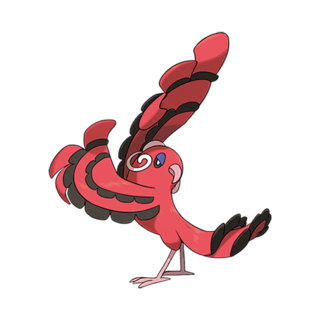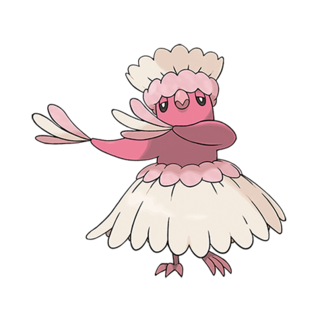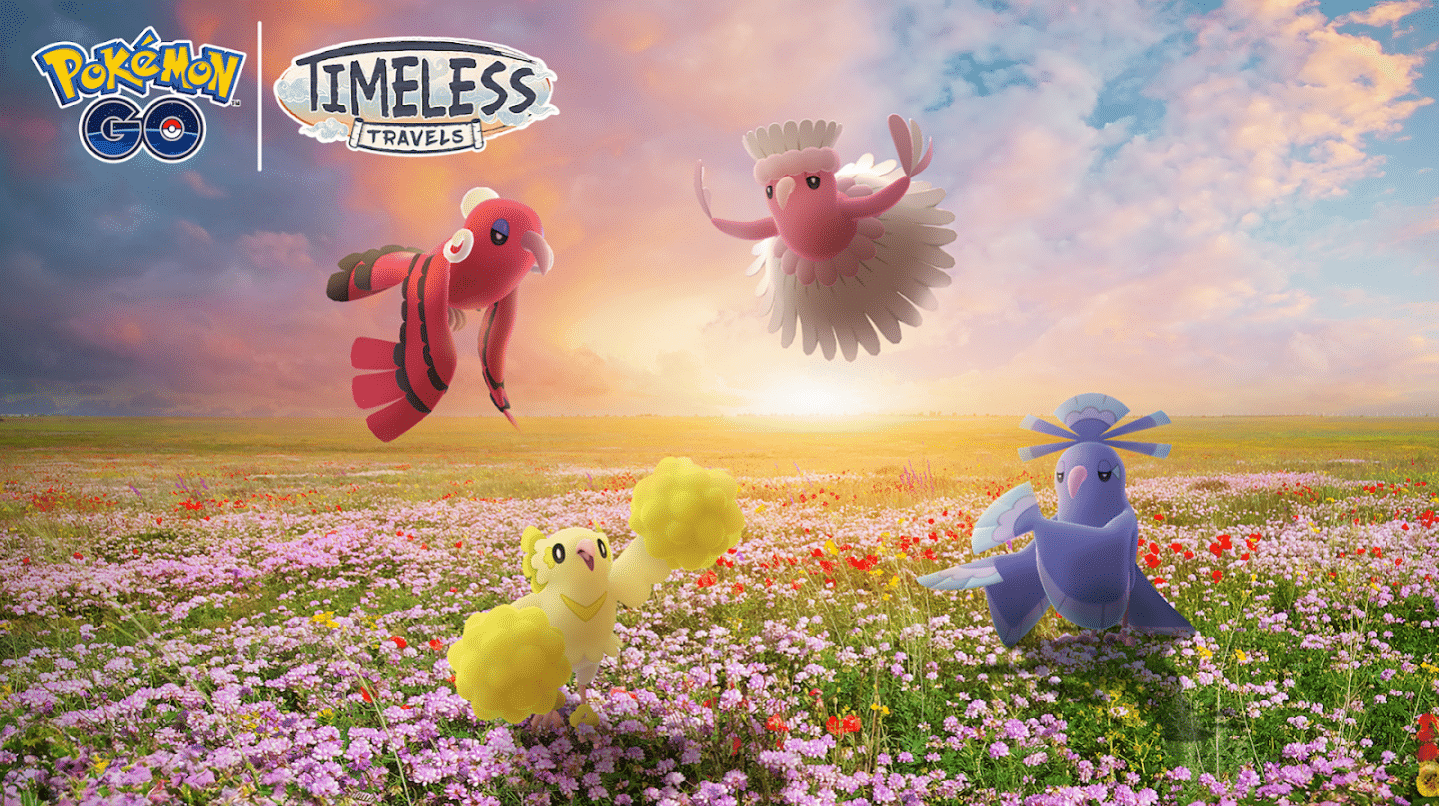Good day, Pokémon Trainers! Have you ever noticed how certain events in Pokémon GO give special attention to a single Pokémon or the community itself tends to hype a new Pokémon up? Have you ever wondered why this Pokémon specifically and what its origins are?
Well, that’s where the Dashing Design series comes in! I’ll be your guide as we take a look at the franchise history, concept, and potential design inspirations of specific Pokémon. Valentine’s Day and The Carnival of Love brought with them the shiny form of all of the Oricorio forms for the first time in GO. So what’s up with Oricorio? Why does it have multiple forms? Let’s take a look and find out!
 Oricorio
Oricorio
Source: Pokémon GO Event Banner
Oricorio, a single-stage Pokémon, made its first appearance in Generation Seven. This generation encompasses the last 3DS mainline games Pokémon Sun, Pokémon Moon, Pokémon Ultra Sun and Pokémon Ultra Moon. Along with the first Nintendo Switch mainline games Pokémon Let’s GO Pikachu and Pokémon Let’s GO Eevee.
The fact that Oricorio made its debut in the Seventh Generation is quite relevant to its design. Pokémon Sun, Moon, Ultra Sun, and Ultra Moon take place in the archipelagic region of Alola, which is primarily inspired by the real-world US State of Hawaii. Alola is primarily divided into four islands. And despite Oricorio not having any evolutions, in these games, you can change Oricorio’s form (which changes its design and type) based on specific “Nectar” items available on each island.
Oricorio would eventually be released on Pokémon GO in 2022 with each form being available in different parts of the world. This is done to allude to how Oricorio works in the aforementioned mainline entries. Other than the games Oricorio made regular appearances in the Pokémon: Sun and Moon anime series. In particular, a Pom Pom Style Oricorio belonging to the anime-exclusive character, Hobbes.
So we’re doing things a bit differently this time around. Oricorio has multiple designs centered around the same base. So along with its name, we’ll take a look at its basic design inspirations before tackling each unique version directly.
Source: Pokémon GO Event Banner
With that being said Oricorio very likely gets its name from “Oriole” (A type of passerine bird) and “Choreography” (The sequence of steps taken in a dance routine). Passerine or “Perching Birds” is a designation given to one of the largest bird families that include the common house sparrows, crows, and the aforementioned Oriole. Choreography is a term commonly used to describe the motions taken in a dance. Which as we will see soon, is very relevant to Oricorio’s various forms.
However, it is worth noting that its Japanese name Odoridori is a combination of “Odori” (Meaning “Dance”), and Tori (Meaning Bird). As a whole its Japanese name also sounds similar to Irotoridori (Meaning Multi-colored). It’s worth noting that this name uses the term “Tori” to mean birds in general rather than mentioning a single species. I personally believe this is more accurate to Oricorio.
Looking at specific characteristics such as the mark on one of the Oricorio’s chests or their individual tail shapes, I couldn’t definitively pin them to a single species, Orioles or otherwise. In fact, a lot of Oricorio’s designs are shared by multiple bird species. And not just Passerine’s either. As Oricorio’s beak shape is more similar to those found in parrots. So ya, I personally think Oricorio is inspired by many common birds. Some of which we could talk about later. As for its dance inspirations though? For that let’s look at each Oricorio specifically. Starting with:
 Oricorio (Pom-Pom)
Oricorio (Pom-Pom)
In the Pokémon Sun, Moon, Ultra Sun, and Ultra Moon games, the Pom-Pom Style Oricorio can be found on Melemele Island. This island is where you start off in those games. So it’s quite fitting that this is the first type of Oricorio you encounter as it is inspired by arguably the most easily recognizable physical performance of the four styles.
A Girl Holding Pom-Poms. Source: Photo by Nathan Anderson on Unsplash
So why is it called the Pom-Pom style? Well, Pom-Poms refer to ball-shaped instruments typically used in cheerleading. And that is exactly what this form of Oricorio is inspired by, cheerleading. Cheerleading is a physical activity that is very closely related to dancing. Where individuals called cheerleaders perform various rhythmic motions (often with pom-poms in both hands similar to what we see with Oricorio), in order to cheer on and hype up teams and the crowds in a given sporting activity. This also explains why this Oricorio is a Electric type as it “energizes” the teams and the audience, much like how many of our appliances today are powered up by electricity.
Nowadays, cheerleading is widely recognized thanks to the popularity of many sports where cheerleading is also performed. So it makes sense for this to be the first Oricorio players see as it is the most likely one for people across the world to recognize. However, despite its worldwide popularity today, it’s important to remember that cheerleading has its roots in the USA. It is also then quite fitting that this form of Oricorio can only be found in the American Continents in Pokémon GO.
As an additional note, this style of Oricorio has a V-shaped crest on its chest. I believe it’s meant to symbolize victory. Much like cheerleaders, who cheer for the victory of their team.
 Oricorio (Pa'u)
Oricorio (Pa'u)
In your adventures in the seventh generation of games taking place in Alola, the second island you’ll come across is Akala. Where you will also find the pink-colored Pa’u style of Oricorio. Pa’u is the Hawaiian word for “Skirt”. In this case, a Hula skirt. Which is very accurate to Pa’u Oricorio as it is inspired by Hula dancers. Hula is a type of dance native to Hawaii.
This style of Oricorio’s feathers are in the shape of a skirt on its waist and also in the shape of a floral headdress on its head. These are meant to look similar to the types of outfits that are worn during Hula. In fact, it has three feathers extending from both wings. This also helps to give the impression of the “arm-waving” motion performed during Hula. Sometimes fans are held on both hands during Hula performance as well which also be what those feathers are alluding to.
A Hula Performance
It Goes Deeper
Nowadays Hula is perhaps one of the most well-known tourist attractions for visitors to Hawaii. Yet, what many might not know is that Hula has its origins as a religious performance. In fact, there are many stories native to Hawaii that state Hula itself was created by a deity. And it has been traditionally performed to please the deities. This relationship to the spiritual world might be why this style of Oricorio is a Psychic type. Along with the general “mentally refreshing effect” one might feel while going on a trip to Hawaii and observing the swaying motions of a Hula dance.
Akala Island is the largest island of the four in Alola with a total of three captains. With the captains being part of the replacements for gym leaders in Alola. So it stands to reason that the Oricorio inspired by a dance from Hawaii would be found here.
Also, Hula has a long history of ups and downs. Active efforts have been and continue to be made to preserve Hula and other Hawaiian traditions. As they were threatened after the modernification of Hawaii. This is actually referenced in the games themselves. As Kiawe, one of the captains of Akala is seen actively making an attempt to preserve the traditional dances of his region. Another reason for Pa’u Style Oricorio to be in Akala Island.
 Oricorio (Baile)
Oricorio (Baile)
Moving on to Ula’ula island, we find the Baile style Oricorio. Which is adorned in striking black and red feathers in both its shiny and regular forms. This is because, with its frilly black-red feathers and earring-like spirals on its ears, this Oricorio is meant to represent a Flamenco performer.
A Flamenco Performance
Flamenco is a type of performance originating from Spain. “Baile” means dance in Spanish and it’s where this style of Oricorio gets its name from. It is one of the three core pillars of Flamenco. These being Guitar, Song, and Dance (El baile flamenco). This might also be the reason for this Oricorio’s part Fire typing.
Flamenco can be seen as being quite passionate. It’s a very lively performance with fast dance movements, along with lots of claps and foot-tapping. Flamenco songs also tend to focus on more human experiences ripe with bursts of human emotion. As opposed to the chants accompanying the aforementioned dance styles. Which have a history of leaning more towards singing praises. Towards teams in the case of cheerleading, and towards deities in the case of Hula.
As to what this Oricorio is doing on a Hawaii-inspired island, I have a theory. Ula’Ula Island is based off of Hawaii Island. And this island is ripe with volcanic activities. It has the Great Crack and the island itself is built from volcanoes. Perhaps these red-hot explosive volcanoes, in a more spiritual sense, harken to the lively passionate performance of Flamenco. True to its Flamenco origins, this Oricorio can be found in areas in Europe among others.
 Oricorio (Sensu)
Oricorio (Sensu)
We reach the final style of Oricorio found on the final island, Poni Island. This is also the Oricorio native to my place of residence here in Asia. Again, quite fitting, considering Sensu Style Oricorio is very Asian, more accurately it’s all Japanese!
Oricorio in this style has more elongated tail and wing feathers. Which makes it look like it’s wearing a kimono. It also has two fan-like extensions on its hands. These are meant to represent folding fans seen across Asia, called Sensu in Japan (Hence the name). This Oricorio also has another fan-like extension on its head along with four stick-like ones. The sticks are obviously meant to be hair sticks giving the impression of decorated hair tied into a bun. All in all, Sensu Style Oricorio has a traditional Japanese woman’s getup and look.
An Ukiyo-e Print of A Geisha. Source: Public Domain Image Collected from Wikipedia
But why though? The first thought that comes to mind is “Geisha”. Geisha are Japanese women well-versed in arts and entertainment. They typically wear specific traditional attire and wear heavy makeup (well, not all of them but that would require a larger discussion). The heavy makeup would also explain the different colored parts next to its eyes.
Though many Japanese artistic forms employ heavy makeup. And the Geisha were and are versed in many types of art and dances. So it doesn’t really help us understand which kind of dance form Sensu Style follows to keep in line with the other Oricorios. So where does our answer lie?
In Theatre
I believe the Sensu Style gets its design from traditional Japanese theatre such as Kabuki and Noh. These theatre performances tend to employ exaggerated motion-driven performances and occasionally song and dances directly. I personally believe it’s more so inspired by Noh. It is one of the oldest forms of Japanese theatre.
And also Sensu Style Oricorio is partly Ghost type and its Pokédex entries refer to curses a lot. As Noh is very traditional it often portrays old Japanese stories. Including stories of Kiyohime and even more accurate to our discussion, Lady Rokujō. Tales of vengeful women who curse those they believe had wronged them.
Source: Aoi no Ue. A Noh Performance About Lady Rokujō
I say Lady Rokujō is more relevant to our discussion because she originates from one of Japan’s oldest surviving pieces of literature “Genji Monogatari”. The stories from which have been adapted to Noh and other theatrical performances many times. In them, Lady Rokujō is seen wearing luxurious traditional garbs. And her vengefulness is such that her spirit leaves her living body to curse Genji’s lineage.
So I’m sure you can see a connection between these plays and our final Oricorio. As for why it’s on a Hawaii-inspired island in Alola, this one’s quite easy. Poni Island, where you find Sensu Style Oricorio is based on the real-life Kauai Island. This island sees huge amounts of Japanese tourism second only to US tourists themselves. So of course this island would have the Japan-inspired Oricorio!
So with that all being said, Why is Oricorio the way that it is? And why is it getting its shiny form for Valentine’s? Well to start with the first question. One potential reason might be the huge diversity in shapes we can see between birds of the same general species. Something Darwin observed among Finches between Islands as well. And Alola is an island nation.
But really, I think it comes down to what I’ve been repeating these past few Dashing Design articles. Ever since the fifth generation of games, Pokémon has had more of a global approach to region design when it comes to the mainline games. With Alola being no different, being inspired by Hawaii. Hawaii being a popular tourist destination, sees a lot of people from different parts of the world come together. Thus making a Pokémon with different forms inspired by different cultures for Alola seems like a no-brainer.
As for why it’s a dancing bird, I believe that can be easily explained as well. Dancing is a very common medium for people to express themselves and amuse each other. Almost every corner of the world has some unique form of moving to a rhythm in an entertaining manner. In fact, this isn’t even limited to humans themselves. As birds also tend to dance to entertain themselves and attract mates.
A Bird’s Dance To Attract A Mate
This along with the fact that birds are often seen as symbols of love, perhaps for their courtship behavior, is why I believe Oricorio is getting its shinies during Valentine’s Day. In fact, while a reason for Oricorio’s bent beak design might be Hawaiian Honeycreepers. They also tend to look like beaks found on parrot-like birds, such as the Lovebirds!
And there we go! Another Dashing Design for this lovely month. Something I’ve omitted so far while talking about Oricorio is that every island in Alola is named after a color in Hawaiian. And the color of each Oricorio is the same as the name of each island. And each island’s name is also based on the official color of the real-world Hawaiian island they are based on. So as an example, Sensu style is purple, which is found on Poni Island, Poni is Hawaiian for purple, and purple is the official color of Hawaii island. So, you see, the Oricorio’s don’t only represent various cultures but also the different cultures of each Hawaiian island Alola is based off of.
And this is why, the Oricorio’s designs, are quite dashing!
Goodbye for now, Pokémon trainers. Priom-out!







